
ACT Science Practice Test 38
Đề thi nằm trong bộ sưu tập: Tuyển Tập Bộ Đề Thi Đại Học Hoa Kỳ (ACT) - Có Đáp Án Chi Tiết
Số câu hỏi: 23 câuSố mã đề: 1 đềThời gian: 1 giờ
201,611 lượt xem 15,504 lượt làm bài
Xem trước nội dung:
Students studying mirrors and reflection were given the following information:
There is a definite relationship between image characteristics and the distance an object is placed with regard to a concave mirror (see Figure 1). If an object is located beyond the center of curvature (C), its reflected image will be inverted (upside down) and smaller than the object itself. If an object is located precisely at C, the image will also be located at C; it will appear inverted and true to the object’s actual size. When the object is placed between C and the focal length (F), the image will be inverted and larger than the object. When the object is located precisely at F, no image is formed whatsoever. Lastly, if an object is placed between F and the mirror, its image will appear upright and larger than the object.
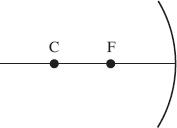
Figure 1
Given no further information, the students were asked to explain how the following magic trick is performed:
A famous Chinese magician conducts a classic magic trick utilizing a concave mirror with a focal length (F) of 1.6 m and a center of curvature (C) of 2.2 m. He is able to utilize the mirror in such a manner as to produce an image of a light bulb at the same location and of the same size as the actual light bulb itself.
Student 1
The light bulb must have been placed exactly 1.6 m in front of the mirror, creating a perfect reflection. The image would thus be in the same location as the light bulb, have the same dimensions as the light bulb, and be an upright image.
Student 2
The light bulb must have been placed exactly 2.2 m in front of the mirror. The image would then be in the same location and have the same dimensions as the actual light bulb, although it would be inverted.
The students disagreed about which aspect of the light bulb’s image?
Its size
Its location
Its orientation
Its shape
The two explanations were similar to each other in that both explanations:
assumed that the image was upright.
assumed that the exact positioning of the light bulb was important.
correctly interpreted the information provided by the teacher.
incorrectly interpreted the information provided by the teacher.
Placing the light bulb in front of the mirror at which of the following distances would have resulted in an upright image?
1.0 m
1.6 m
2.2 m
2.6 m
Did Student 2 provide an adequate explanation of the magic trick?
No. Student 2’s explanation included an image that was upside down.
No. if the light bulb were placed at 2.2 m, it would not have produced an image.
Yes. 2.2 m is the center of curvature. Placing an object at C results in an image of the same size in the same place.
Yes. The magician specified that the image was inverted; Student 2 was the only student to account for this.
All of the following statements concerning concave mirror reflections are true EXCEPT:
an object placed anywhere in front of C (closer to the mirror) will produce a reflected image that is larger than the actual object.
an object placed anywhere in front of F (closer to the mirror) will produce an upright reflection.
an object placed anywhere beyond F (farther from the mirror) will produce an inverted reflection.
the only possible way to produce a reflected image equal in size to the actual object is to place the object precisely at
The teacher posed another question to the students. The students were told that the magician performed another trick in which he relocated the light bulb so as to create the illusion that it had disappeared completely. How far in front of the mirror must the light bulb have been placed in order to NOT produce a reflection?
1.3 m
1.6 m
2.0 m
2.2 m
Assume that Student 2’s explanation is correct. If the magician wanted to create an image of the light bulb that was smaller than the light bulb itself, at which of the following distances in front of the mirror could he place the light bulb?
1.6 m
2.0 m
2.2 m
2.5 m
Friction is the force that resists movement when two surfaces are in contact and is represented by Ff. The coefficient of friction (COF, symbolized by μ) is a quantity used to measure the force of friction based on the normal force (FN). There are two COF’s for a given surface-to-surface contact: static COF (μs) and kinetic COF (μk). μs is used for objects at rest and μk is used for objects in motion. The normal force is an upward force, perpendicular to the surface the object is either resting on or moving on.
The basic equation for calculating the coefficient of friction is:

Figure 1 is a diagram of a block resting on an inclined plane. The forces shown are defined above. FG represents the force of gravity.
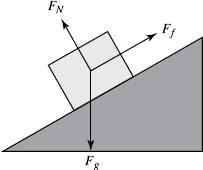
Figure 1
Scientists performed an experiment using several different materials to determine μs and μk for each pair of materials. Figures 2 and 3 show the results.
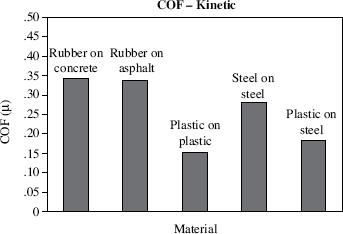
Figure 2
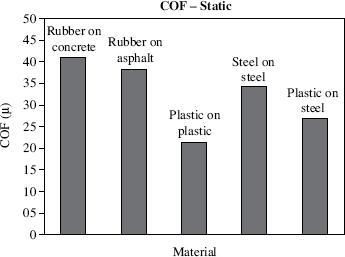
Figure 3
Based on the results of the experiment, which combination of materials has the largest static COF?
Plastic on plastic
Plastic on steel
Rubber on concrete
Rubber on asphalt
A comparison of the COFs given in Figure 2 shows that, relative to the COF for rubber on concrete, the COF for plastic on plastic is approximately:
1/100 as high.
1/2 as high.
2 times as high.
10 times as high.
Which of the following ranks the materials used in the experiment from lowest static COF to highest static COF?
Plastic on plastic, steel on steel, plastic on steel, rubber on asphalt, rubber on concrete
Rubber on concrete, rubber on asphalt, steel on steel, plastic on steel, plastic on plastic
Plastic on steel, plastic on plastic, rubber on asphalt, rubber on concrete, steel on steel
Plastic on plastic, plastic on steel, steel on steel, rubber on asphalt, rubber on concrete
A student theorized that the higher the static COF for a material, the higher the kinetic COF would be. Do the results of the experiment support this theory?
Yes. The materials with the highest static COF also had the highest kinetic CO
Yes. Plastic on steel had both the highest static COF and the highest kinetic CO
No. Plastic on plastic had both the lowest static COF and the lowest kinetic CO
No. There is no relationship between static COF and kinetic COF for any of the materials.
According to Figures 1, 2, and 3, which block would most likely slide down the incline the fastest?
A steel block on a steel incline
A plastic block on a plastic incline
A rubber block on a concrete incline
A plastic block on a steel incline
The main source of the world’s energy for the last century has been fossil fuels. To use fossil fuels, we must be able to locate and recover them at affordable costs, convert them to usable forms, and use them without wasting them or harming the environment.
Experiment 1
Scientists set out to determine the energy potential of various fossil fuels. They burned 1 ton of each of 5 different fuel varieties, and measured the energy produced. Table 1 shows the energy content of various fossil fuels.
Table 1
| Fuel | Energy Content (Btu/Ton) |
| Coal | 25,000,000 |
| Crude oil | 37,000,000 |
| Gasoline | 38,000,000 |
| Natural gas | 47,000,000 |
| Peat | 3,500,000 |
Experiment 2
Students completed an experiment to measure the heat energy obtained from natural gas, using water, a Fahrenheit thermometer, and a Bunsen burner (see Figure 1). They filled a beaker with enough water to
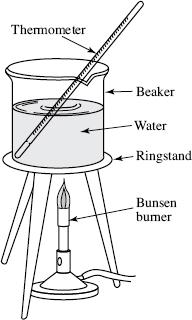
Figure 1
weigh 1 pound (approximately 450 mL). They recorded the temperature of the water, then lit the Bunsen burner and stirred the water continuously. They took several measurements of the water’s temperature, at 5-minute intervals. The results of the experiment are displayed in Table 2.
Table 2
| Time (m) | Water Temperature (°F) |
| 0 | 67° |
| 5 | 92° |
| 10 | 117° |
| 15 | 142° |
Each type of fossil fuel releases a different amount of energy. This energy is measured in a variety of units. Table 3 provides a conversion chart for energy units.
Table 3
| 1 Btu = | .252 kilocalorie .000293 kilowatt-hour |
| 1 kilocalorie = | 3.97 Btus .0012 kilowatt-hour |
| 1 kilowatt-hour = | 3,413 Btus 860 kilocalories |
| 1 barrel of oil = | 5,600,000 Btus 1,410,579 kilocalories 1,640.8 kilowatt-hours |
According to the results of Experiment 1, which of the following ranks the different types of fossil fuels in order of energy potential, from the most Btus/ton to the least?
Peat, coal, crude oil, gasoline, natural gas
Natural gas, gasoline, crude oil, coal, peat
Gasoline, crude oil, peat, coal, natural gas
Natural gas, crude oil, peat, gasoline, coal
If 1 Btu is the amount of heat needed to raise the temperature of 1 pound of water 1° Fahrenheit, then how many Btus of natural gas were used during the first 5 minutes of Experiment 2?
92
67
50
25
The main purpose of Experiment 2 was to:
determine the amount of energy natural gas creates.
compare various fossil fuels to see which one produces the most energy.
see how long it would take to heat water to 100°
calculate how much water is necessary to burn 25 Btus of natural gas.
If Experiment 2 had been repeated using gasoline to heat the water instead of natural gas, the temperature of the water after 10 minutes would most likely have been closest to which of the following?
40° F
99° F
117° F
180° F
According to the data in Table 3, which unit of energy is equivalent to the most Btus?
1 kilowatt-hour
1 kilocalorie
1 barrel of oil
10,000 Btus
Based on the results of Experiment 2, if temperature had continued to be measured for 5 more minutes, what would the temperature of the water have most likely been at the next measurement?
85° F
142° F
167° F
200° F
The growth of tumor cells in a culture depends on the amount of nutrients in the culture. Cell production can be determined by counting the number of cells. The effects of various concentrations of glucose and calcium on the growth of three different cell types were tested. Each culture dish began the test with 0.5 million cells, to which was added a solution containing known concentrations of either glucose or calcium. The results after three days are shown in Figures 1 and 2.
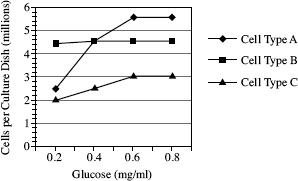
Figure 1
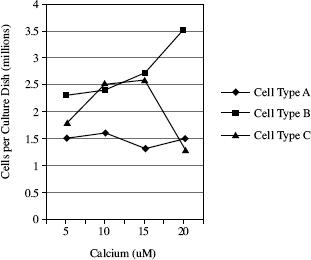
Figure 2
Which of the following variables is represented by the y-axis of the graphs?
The number of cells per culture dish after three days
The concentration of glucose or calcium present in the solution after three days
The number of cells added to each culture dish on the first day
The concentration of glucose or calcium present in the solution on the first day
According to Figure 1, which cell type(s) produced the largest number of cells with a glucose concentration of 0.4 mg/ml?
Cell type A
Cell type B
Both cell types A and C
Both cell types A and B
Based on the trends in Figure 2, which of the following statements about cell behavior could you predict if 25 uM of calcium were introduced?
Cell type B would produce around 4 million cells.
Cell type A would produce around 2 million cells.
Cell type C would produce around 2.5 million cells.
Cell type C would produce around 0 million cells.
Based on the information in Figures 1 and 2, one would predict that the growth of cell type A would be greater than that of cell type C in solutions containing all of the following EXCEPT:
0.2 mg/ml of glucose and 20 uM of calcium.
0.2 mg/ml of glucose and 15 uM of calcium.
0.4 mg/ml of glucose and 20 uM of calcium.
0.6 mg/ml of glucose and 20 uM of calcium.
Based on the data in Figures 1 and 2, what can be concluded about the effectiveness of using glucose versus calcium to stimulate cell growth?
In all cell types, calcium is more effective than glucose at stimulating cell growth.
In all cell types, glucose is more effective than calcium at stimulating cell growth.
Calcium is more effective than glucose at stimulating cell growth in cell type
Glucose is more effective than calcium at stimulating cell growth in cell types A and
